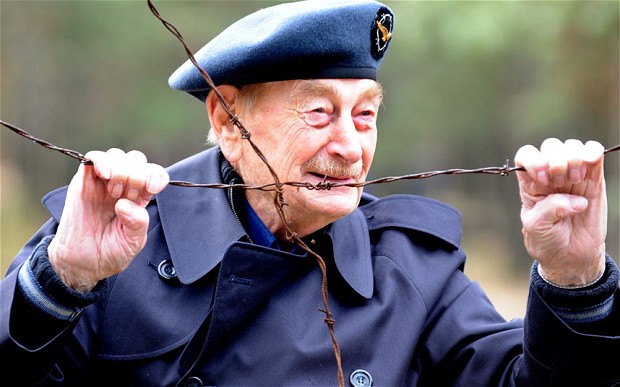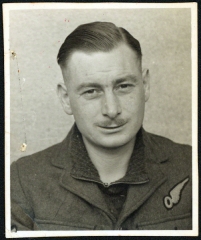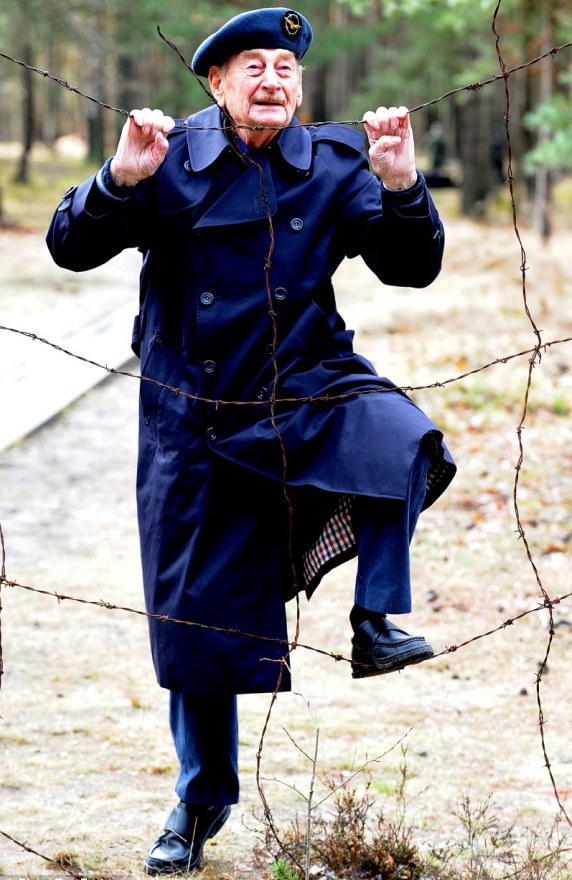Squadron Leader Alfie Fripp RAF
13 June 1913 - 3 January 2013

Association Members may have had sight of the widely-reported news of the death of Squadron Leader Bill 'Alfie' Fripp, who was serving with 57 Squadron as a Bristol Blenheim observer/navigator at the outbreak of WWII, and who was shot down on a reconnaissance mission on 16 October 1939 along with his pilot, Flying Officer Michael Casey, and Air Gunner, Aircraftsman Nelson. Alfie spent the rest of the war in captivity, and was the archetypal 'pain in the backside' for the Germans!
In today's RAF, we speak about those who are captured as 'Prisoners at War' rather than 'Prisoners of War', to reflect the fact that, although they may have been captured, our prisoners continue to fight the war, albeit in a different environment. Alfie was one of those who pre-empted the change from PoW to PaW by many decades.
I was fortunate enough to first meet Alfie in 2009, when I attended an RAF Kriegies presentation at RAF High Wycombe, and heard Alfie talk about the mission he was shot down on. It suddenly dawned on me that Alfie must have been serving with 57 Squadron at the time, a fact he confirmed when we spoke over a cup of tea later (the precursor to many subsequent beers). After that, Alfie became an integral part of our Association and a friend.
With Alfie's death, we have lost the last of the '39ers' - those who were captured in 1939, but we won't forget them. Rather than attempt to encapsulate Alfie's life and Service, it is probably best if I simply provide Association Members with a snapshot of Alfie's life taken from his website (text in italics) ( www.alfiefripp.com ).
After this early disappointment, Alfie was told that the RAF was looking for apprentices and there were no height restrictions. Invited to take the entrance exam, he passed and chose to become an electrical apprentice. Along with other new recruits, Alfie was enlisted at RAF Halton on 30 September 1930 and proceeded to RAF Cranwell to the E.W School. After two years of training, the recruits were told that the electrical training was to become the electrical instrument trade and were given the option on transferring to the Wireless Operator course. Knowing that there was more chance of becoming aircrew, Alfie took the opportunity and transferred.
em>Following qualification in 1933, Alfie was posted to 201 Sqn (Flying Boats) based at Calshot, near Southampton. Three years later, a transfer to 205 Sqn in Singapore – the first RAF squadron to be permanently based in the Far East. A brief sojourn at RAF North Coates in 1938 was swiftly followed by another transfer, this time to 57 Sqn at RAF Upper Heyford.
At the outbreak of the Second World War, 57 Sqn was transferred to Amy, France as [part of] the Air Component of the British Expeditionary Force (BEF) in France for strategic reconnaissance duties. More importantly, three days after the declaration of war, on 6 September 1939, Alfie married Vera Violet Allen. A very short honeymoon was taken after which it was back to work for Flight Sergeant Fripp. If only Alfie and Vera had known the future they may have perhaps taken a longer honeymoon!
Alfie’s story of he how he fell into Nazi hands is best told by the man himself… "We were on a photo recce from Amy, near Amiens, to photo the railway activity from Munster to Hamburg, in Germany. The intelligence briefing was somewhat sketchy with no mention being made that Munster was a Luftwaffe fighter HQ with three squadrons attached. We flew to Metz to refuel before crossing the border and aiming to collect a fighter escort into Germany. There were no fighters available so we proceeded to the target solo. Cloud base over the target was about 10,000 feet so we descended below to carry out a line overlap with our f8 camera in the bomb well.
Having carried out the operation, we set course for base but flak started to appear around the aircraft. The pilot decided to head for Britain so we altered course. With very little cloud cover the Air Gunner soon informed us that an enemy fighter was coming up fast. The first burst came streaming through the aircraft knocking out the rear gun but fortunately not hitting the aft gunner.
The pilot, Flying Officer Casey, then decided to dive into what little cloud cover there was hoping to lose the Messerschmitt ME109 on our tail. There was no way; however, we were able to avoid the occasional machine gun burst so we went into a steep dive to within tree top height.
After what seemed like an age, smoke was coming into the cockpit from smouldering engine covers stowed in the bomb well. Then we hit a tree top which caused the port engine to fail and the windscreen to shatter and, with it, our hopes of reaching friendly territory. Casey told the crew to prepare for a crash landing. We landed in a potato field and all three crew got out with just shock, minor scratches and bruises. Our aircraft, though, was in a mass of flames.
The Luftwaffe from an airfield a few miles away, spectators to the chase, picked us up. That evening we began our internment as PoWs at their HQ at Munster where we spent three days being interrogated. We were subject to solitary confinement but were allowed out together for an evening meal under strict supervision. And so by rail to my first PoW camp."


Alfie pictured shortly after capture and Telegram with the unconfirmed report of Alfie's capture
Over the next 5½ years, Alfie was incarcerated in 12 different PoW Camps, including Stalag Luft III, Sagan (where the 'Great Escape' took place). An inveterate forager and fixer, Alfie helped to procure supplies and tools for many escape attempts, including the Great Escape itself. Although he was moved from Stalag Luft III some 3 months before the escape itself, Alfie's pilot Michael Casey took part in the escape, but sadly was one of the 50 airmen who were recaptured and murdered by the Gestapo.
After the war, Alfie remained in the RAF and rose to the rank of squadron leader before he retired from the Service in 1969, when he started a second career as a teacher. He eventually returned to the sight of Stalag Luft III in 2009, and said at the time; ‘The most important thing is saying goodbye to those who died. The huts have all gone but the ghosts of all those boys are here. I'm glad I came to remember Mike – you reflect back on all the memories and the people you knew. As for the Germans, I've forgiven them but not forgotten.'
